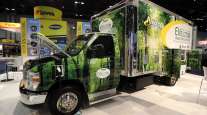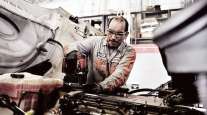Fan Drive Technology Is Evolving to Meet the Needs of Modern Engines
[Stay on top of transportation news: Get TTNews in your inbox.]
When exhaust-gas recirculation became the technology to meet the heavy-duty truck emissions standards introduced in the early 2000s, underhood temperatures skyrocketed, and cooling system demands loaded up.
It was too much for cooling fan drives and belts, said Darry Stuart, a truck maintenance executive and past general chairman of the Technology & Maintenance Council of American Trucking Associations.
Failures centered on bearings, and a catastrophic failure would also take out the radiator, he said.

Sturgess
Joe Stianche, a retired fleet manager and recipient of TMC’s Silver Spark Plug award, agreed.
“I have had some experience with fan drive failures, even to the extent they would end up in the radiator. And I would agree that the on-off fan drive could be hard on the old belt package,” he said in a recent interview.
But since then, things have come a long way. In addition to the traditional on-off drive, fleets also can spec a variety of variable-speed and electronically controlled fan drives.
“The new Visctronic drives have evolved to deliver improved idle speed by reducing bearing drag,” said Jim Ward, director of application engi- neering at fan drive supplier BorgWarner. “They have increased slip heat capacity.”
This is a big turnaround.
“We did some testing way back when looking at on-off drives versus viscous drives,” Stianche said. “Then viscous was the loser overall. You could never tell if they were working right, and even when not in use, they would still be a drag on the engine and eat up horsepower.”

A fully variable fan drive in a Kenworth operated by Olinger Heavy Hauling. (Horton)
BorgWarner’s Ward said the latest generation of fan drive technology offers a range of benefits.
“Visctronic delivers a broader range of modulation,” he said. “Its increased torque capacity allows new, more aggressive fans to be applied, which can generate airflow at lower engine speeds, or without the need for pulley ratio increases. Another important improvement is the quick disengagement at cold conditions, which reduces noise and improves the fuel efficiency during the warmup phase.”
They are standard now on Freightliner Cascadias in Mexico.
“Reliable and efficient airflow is critical to keeping trucks on the road and costs down,” said Daniel Paterra, president and general manager of BorgWarner Thermal Systems. “In applications with high loads, hot climates or high elevation changes, fan engagement times dramatically increase. BorgWarner’s Visctronic fan drive delivers efficient and reliable cooling in these tough operating environments.”
Horton, another supplier of fan drives, is focusing on variable-speed drives to advance the capabilities of its products, said Mathew Stahl, on-highway product manager.
“The variable-speed viscous drives are the most effective way to control a fan to the commanded speed, and in turn the best way to match the cooling requirements,” he said. “Widely utilized in Europe, viscous drives are beginning to gain adoption in the U.S. We’ve taken what we’ve learned over the years and applied it to viscous drives to create the most efficient solution available.”
Bulk carrier Kenan Advantage Group utilizes viscous fan drives in many of its tractors.

A look at Horton’s fully variable LCX230 fan drive. (Horton)
“On the Peterbilts we run in the United States, we spec the Horton RCV250 and have had good luck with it,” said Kirk Altrichter, vice president of fleet services. “It holds up well, and there’s not as much parasitic loss, because it is a viscous drive.”
Altrichter, who is also a past TMC general chairman, is responsible for tank trucks that always load out at the maximum gross weight and often operate in crowded traffic or mountainous applications, which place heavy demands on cooling systems. “The viscous drive is less noticeable than the clutch-engaged fan. You can always feel it when it kicks in,” he said.
Although viscous fan drives are enjoying much greater popularity today, there’s still a place for other drives depending on the application, Horton’s Stahl said.
“Our DM Advantage Friction On/Off has extremely low disengaged speed and minimal complexity. It’s great for longhaul, over-the-road applications where fan engagements are minimal due to enough ram air passing through the coolers,” he said. “The Friction Two-Speed is used in applications when there is a lack of ram air coming through the coolers. Vocational applications benefit from an elevated disengaged speed. This reduces the number of full fan engagements required.”

A Visctronic fan drive from industry supplier BorgWarner.
BorgWarner’s Ward said fan time varies significantly according to the application.
“The fan time for a longhaul truck will be a lot different from a heavy-duty vocational, or from a medium-duty delivery truck,” he said. “Because fan time draws power from the engine and therefore has impact on fuel economy, OEMs are globally migrating to electronic-controlled, fully variable speed drives, which will help them achieve the required fuel efficiency.”
This extends to fan design, which is entirely the purview of the cooling experts.
“We don’t spec the fan blade, and I’m not sure we could if we wanted to,” Altrichter said.
BorgWarner’s Ward said plastic fans are typically lower mass, which reduces engine load. “We are also able to form more complex shapes in plastic than with aluminum or steel, which improves efficiency and reduces noise.”
Horton’s Stahl reiterated that point.
“The MS and HS series fans can be configured from six to 11 blades, and 22 to 32 inches in diameter, to meet a wide range of application requirements for medium- and heavy-duty trucks,” he said. “We’ve worked with OEMs to develop fan blade designs that specifically benefit and improve efficiency for their application.”
Jim LeClaire, a Silver Spark Plug recipient and recognized associate of TMC, has the last word: “You get the best you can from the truck OE. They do the aerodynamics, cooling system design and fan and drive testing and reliability on the dyno and test track. It’s very integrated now. Today, it’s engineered as a system.”
Want more news? Listen to today's daily briefing:




